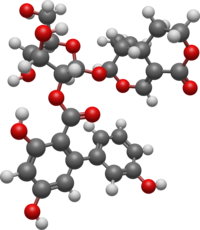Amarogentin
 Chemical structure of amarogentin
| |
 Chemical structure of amarogentin
| |
| Names | |
|---|---|
| IUPAC name
(4aS,5R,6S)-5-Ethenyl-1-oxo-4,4a,5,6-tetrahydro-1H,3H-pyrano[3,4-c]pyran-6-yl β-D-glucopyranoside 2-(3,3′,5-trihydroxy[1,1′-biphenyl]-2-carboxylate)
| |
| Systematic IUPAC name
(2S,3R,4S,5S,6R)-2-{[(4aS,5R,6S)-5-Ethenyl-1-oxo-4,4a,5,6-tetrahydro-1H,3H-pyrano[3,4-c]pyran-6-yl]oxy}-4,5-dihydroxy-6-(hydroxymethyl)oxan-3-yl 3,3′,5-trihydroxy[1,1′-biphenyl]-2-carboxylate | |
| Identifiers | |
3D model (
JSmol ) |
|
| ChEBI | |
| ChEMBL | |
| ChemSpider | |
ECHA InfoCard
|
100.166.688 |
PubChem CID
|
|
| UNII | |
| |
| |
| Properties | |
| C29H30O13 | |
| Molar mass | 586.546 g·mol−1 |
Except where otherwise noted, data are given for materials in their standard state (at 25 °C [77 °F], 100 kPa).
| |
Amarogentin is a chemical compound found in gentian (Swertia chirata.[1]

Gentian root has a long history of use as a herbal bitter in the treatment of digestive disorders and is an ingredient of many proprietary medicines. The bitter principles of gentian root are
bitter natural compounds known[2] and is used as a scientific basis for measuring bitterness. In humans, it activates the bitter taste receptor TAS2R50.[3] The biphenylcarboxylic acid moiety is biosynthesized by a polyketide-type pathway, with three units of acetyl-CoA and one unit of 3-hydroxybenzoyl-CoA, this being formed from an early shikimate pathway intermediate and not via cinnamic or benzoic acid.[4]
It also shows an
inhibitor of topoisomerase I.[6]
See also
References
- S2CID 21149742.
- ^ Heilpflanzen:Gentiana lutea Archived 2009-09-02 at the Wayback Machine (German)
- PMID 19817411.
- .
- PMID 10590280.
- PMID 8984149.
